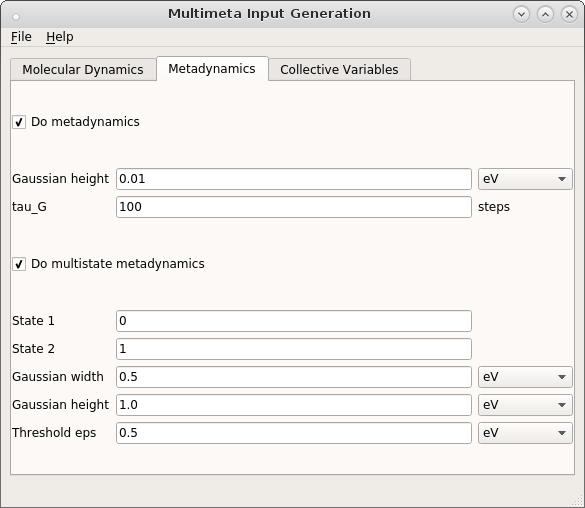Multistate metadynamics¶
The core functionality of the metafalcon package is the multistate metadynamics implementation
(J. O. Lindner, M. I. S. Röhr, R. Mitrić, Phys. Rev. A 97 (5), 052502 (2018)). In this method,
the electronic Born-Oppenheimer two-state Hamiltonian  is extended by an
off-diagonal potential
is extended by an
off-diagonal potential  that is determined by an instance of the metadynamics method
and is therefore dependent on a set of collective variables (CVs).
that is determined by an instance of the metadynamics method
and is therefore dependent on a set of collective variables (CVs).

Diagonalization yields the effective energy gap

which is used as a CV for the multistate metadynamics run.
In order to set up the simulation, run the GUI application and check the Do multistate metadynamics option in the metadynamics tab.

The forms below that checkbox refer to the construction of  , while the Gaussian height
in the upper part of the window is used for the Gaussians added to
, while the Gaussian height
in the upper part of the window is used for the Gaussians added to  .
.  is
the threshold that is used for the
is
the threshold that is used for the  -function to switch between
-function to switch between  and
and
 .
.
The Collective Variables tab also refers to the metadynamics in  . Since the torsion
angle used in the previous example is an appropriate choice for the multistate
metadynamics, we don’t make any changes in this tab.
. Since the torsion
angle used in the previous example is an appropriate choice for the multistate
metadynamics, we don’t make any changes in this tab.
Run the simulation:
metaFALCON run
During the simulation, two files deltaE_meta.dat and deltaE_BO.dat are written that contain the
energy gaps  and
and  .
.
The offdiagonal potential  is handled just as a normal metadynamics instance, so the
input information about the latter is stored in another section of the meta-config.json file. It
is distinguished from the main metadynamics instance with the extension _multistate:
is handled just as a normal metadynamics instance, so the
input information about the latter is stored in another section of the meta-config.json file. It
is distinguished from the main metadynamics instance with the extension _multistate:
{
...
"metadynamics_multistate": {
"collective variables": [...],
"tau_g": ...,
...
},
...
}
This extension is needed later when referring to the multistate instance again, for example when
reconstructing  :
:
metaFALCON reconstruct --extension multistate